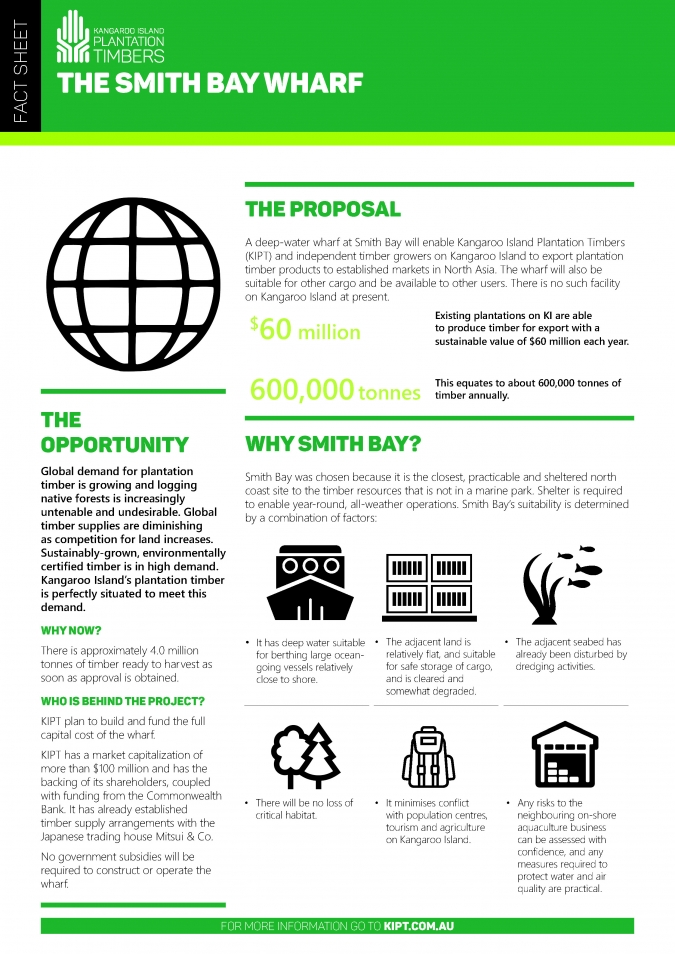The Kangaroo Island community has many questions about KIPT and its plans. The following FAQ has been developed in response to some of those questions. We will continue to add information here and in other places on the website. If you have a question you would like answered, please do so here.
What does this project involve?
Kangaroo Island is home to thousands of hectares of mature softwood and hardwood plantations, mainly in the western part of the Island. Kangaroo Island Plantation Timbers is developing a sustainable forestry industry to unlock the value of these plantations. Environmentally certified timber and chip will be exported from the Island to national and international markets from a new multi-purpose wharf at Smith Bay.
How many jobs will be created?
About 160 jobs will be directly created in forestry and related activities. Flow-on employment is expected to create an additional 74 jobs on Kangaroo Island. In all, we expect the project will boost population on the Island by about 450 people.
How much is the timber worth?
We estimate that we will be able to sustainably harvest about 500,000 tonnes of timber and wood chip a year. This has a value of around $60 million annually which will provide a significant boost to South Australia’s economy.
Do you have any potential customers?
We have signed a Memorandum of Understanding with international trading house Mitsui, which will give them access to the valuable Kangaroo Island timber products (chip and log) to sell to international markets.
Are any native forests affected by these operations?
No, all the timber will be sourced from plantations. Most of the timber is bluegum with a smaller percentage being pine.
When do you expect to be operational?
Once we receive Government approval, we expect it will take nine months to build the new wharf, with the first exports being shipped shortly afterwards.
How far away are you from having the necessary approvals?
The Smith Bay wharf has been declared a major project by the South Australian Government and is subject to a rigorous assessment process before it can be approved by the Minister for Planning. The independent Development Assessment Commission (DAC), prepared a report on the proposal for Government. This report examined all environmental and biodiversity issues to determine what conditions will need to be met for the project. KIPT has prepared its Environmental Impact Statement in response to that report. Find out more about the approval process here.
Why are you proposing to use Smith Bay to develop the new export wharf?
Smith Bay is the best site on the Island given where the forests are located, the proximity to deep water and general impact on the Island.
Are there any other suitable sites that could be used instead of Smith Bay?
No other site meets the needs of the project as well as Smith Bay.
Will the wharf be available to other producers to export goods?
Yes, the wharf will be a multi-user facility and available to other Island businesses.
Will the Smith Bay development impact on the Yumbah Abalone operation at Smith Bay?
Yumbah pumps sea water from Smith Bay into growing pens based on land where the abalone are grown. Highly qualified marine scientists and aquaculture experts we have engaged say the wharf will have minimal impact on their operations, either during construction or operation. We are willing to work with Yumbah to address any particular issues they may have. We are fully committed to maintaining water quality in Smith Bay.
What impact will the forestry operations have on the Island’s roads?
We have sought reports from traffic engineers to fully determine this impact. One of the reasons that Smith Bay is the most appropriate wharf site is that it minimises the distance trucks will have to travel on KI’s roads and the interaction of forestry traffic with local and tourist traffic.
Will the project require any financial assistance from the State Government?
No, it is fully funded. By KIPT.
What impact will the project have on Island wildlife?
This will be fully assessed during the EIS process, but we believe it will be minimal.
What impact will the project have on the marine environment?
Again, this will be fully assessed during the EIS process, but we believe it will be minimal.
Who is the company behind the project?
Kangaroo Island Plantation Timbers is a company listed on the Australian Stock Exchange (ASX:KPT). The majority of shareholders are based in Australia. All the directors are Australian. People interested in purchasing shares should talk to their stockbrokers.
Who owns the plantations on Kangaroo Island?
In April 2017, Kangaroo Island Plantations Timbers completed the purchase of the Kangaroo Island Forestry Investment Trust managed by New Forests Asset Management. The sale delivered 19,000 hectares of land of which almost 11,000 hectares is planted to Tasmanian Blue Gum. This effectively quadrupled the KPT plantation area and tripled its standing timber resource. KIPT owns about 86% of the plantation timber on Kangaroo Island. Twelve independent growers on the island are being consulted about their timber.
